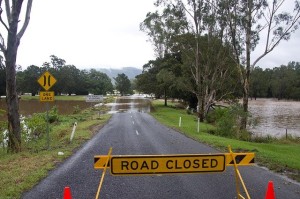Preparing for Storms and Floods in the 2021-22 Summer Season
December 20, 2021 - 4 minutes read
Flooded road in Australia: Image from Pixabay
This summer season in Australia looks like being another soggy one! So if your church is in a risk zone for storms and floods, you should start preparing now
The Bureau of Meteorology says La Niña is firmly established in the tropical Pacific, increasing the chance of above-average rainfall across much of the country.
La Niña occurs when ENSO (El Niño Southern Oscillation) enters a cooling phase. In turn the atmosphere responds to the changes in ocean temperatures – with the results being more rainfall, more frequent cyclones, and earlier monsoon seasons.
The good news is Australia gets more rain and our reservoirs get a top-up. The not-so-good news is it can result in heavy storms and flooding – as we are currently seeing on the east coast.
The effect of La Niña can sometimes last for several years. In this case the weather bureau expects it to last at least until late summer or early autumn of 2022.
Organisations at risk of storms and floods that fail to prepare for can end up in a very vulnerable position. For example, in 2010 when the last La Niña occurred, businesses in NSW and Queensland that failed to prepare for floods suffered some significant losses.
So if your church is at risk, now is the time to act by preparing your property, developing plans for storm and flood emergencies and business continuity, and preparing for post-flood recovery.
1. Preparing your property for storms and floods
You can prepare your property by:
- checking for any drainage issues
- maintaining your roof and clearing gutters
- securing any items that could become missiles in strong winds, and
- sandbagging if necessary to protect against floodwaters.
2. Developing emergency and continuity plans
The goals of your emergency and continuity plans should be to keep people safe, reduce the risk of property damage and financial losses, and to get back to normal operations as soon as possible.
Some of the factors to consider for this include:
- when to enact your plan – that is, what the triggers will be
- safe evacuation of the building
- communicating with key suppliers and clients
- informing staff members and volunteers
- contacting emergency services
- administering First Aid
- arrangements for ongoing operations (temporary alternative premises for example)
- protection of your data
- ongoing planning for employees and jobs
- ensuring you are adequately covered through insurance for property and business interruption.
3. Planning for recovery
What you do afterward can make a big difference to how well you recover from catastrophes.
Some factors to consider:
- site safety and security
- salvaging contents and safely removing debris
- calling in contractors for repairs
- returning employees to work
- trauma counselling where required
- claiming on your insurance (see below).
Insurance cover
Your insurance cover not only provides cover for property losses but also for business interruption or ‘consequential loss’ due to catastrophes. To discuss your policy or for assistance managing your church’s risks, call us on 03 9488 8800 or send an email to hello@cofcinsurance.org.au.
Helpful links and resources
For assistance in developing plans for storms and floods, refer to the Storm and Flood Risk resources page on the Ansvar Insurance website.
Written by Tess Oliver
Tags: emergency, weather
Recent Comments